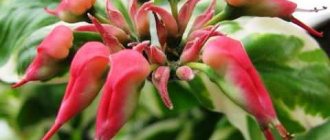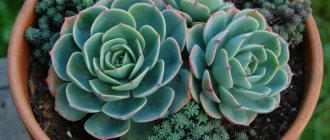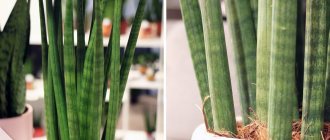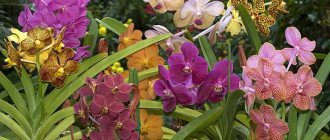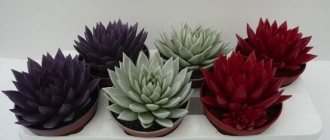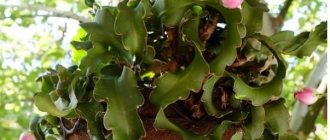Growing miniature trees is an entire art and direction of Bonsai. Portulacaria is well suited for these purposes, a plant native to the arid places of Africa, able to accumulate water and classified as a succulent. In nature, this is a tree or bush, but you can grow one in miniature at home. They love it for its unpretentiousness and ease of cultivation.
Author of the article
Anna Dmitrieva
Gardener with 15 years of experience.
Portulacaria species
The genus includes five plant species, including: African portulacaria - in its homeland it grows up to 3 m, thick light green leaves. The trunk is covered with wrinkled dark brown bark, smooth. Rarely blooms indoors;
- Portulacaria African form is variegated - shorter in height, green leaves with white stripes along the edges. Lack of lighting affects the variegation: it disappears. If the lighting is good, variegated portulacaria becomes compact: the leaves are small with a pink stripe along the edge, the trunk is dark;
- Portulacaria African form variegated cultivar - small size, small leaves, variegation in the middle of the leaf blade. Insufficient lighting causes the disappearance of variegation; in good lighting, the plant is compact, the leaves are small with a pinkish tint, and the trunk is red.
Description of the plant
Portulacaria afra or African is the most popular species of the small genus Portulacaria. This succulent is native to South Africa.
Interesting! Previously, the genus Portulacaria included only the species Afra, but in 2014, after phylogenetic tests, several species of Ceraria were also included in it.
Portulacaria is a perennial shrub or tree. At home, if the plant’s growth is not limited, its stems grow up to 2-3 meters. Over time, the shoots of a rich red hue become lignified, becoming covered with wrinkled brown-red or gray-red bark. The annual growth of shoots in indoor portulacaria flowers is small, so they can remain a compact bush for a long time.
Portulacaria leaves
Fleshy leaves grow on dense, branching stems. They have a smooth and shiny surface, painted in a solid green color. The leaves are small, round or oval in shape, sometimes with a pointed tip. The root system of portulacaria is powerful; the plant needs it during dry periods. Leaf blades are present only on young shoots and branches; on old ones they dry out and fall off over time.
Another name for Portulacaria afra is elephant tree. African elephants love to eat this plant, which is why it gets its name.
Flowering of Portulacaria afra
The succulent blooms profusely with small light pink flowers with five petals. They are formed at the tips of the shoots: axillary spikelet-shaped inflorescences can sometimes be mistaken for a continuation of the stems. Flowering occurs in February-April.
Portulacaria flowers
Important! Indoor young succulents hardly bloom. This can occur as early as adulthood and under ideal environmental and care conditions.
| Mature plant size | up to 1 m in an apartment and up to 2-3 m in nature |
| Lifespan | more than 10 years |
| Bloom | blooms profusely with pink flowers; cluster-shaped inflorescences; flower size up to 2.5 cm |
| Fruit | forms fruits |
| Aroma | absent |
| Safety | not poisonous |
| Difficulty of care | unpretentious; hardy |
| Uniqueness | rare |
| Where can I buy |
|
Features of care
Portulacaria is unpretentious in care; even beginning gardeners can grow it. The plant requires a minimum of conditions for comfortable growth.
In order for portulacaria to develop normally, it needs bright lighting, including direct sunlight.
The plant should be placed on windows facing south. It is recommended to periodically rotate the plant to keep the crown looking beautiful.
In winter, portulacaria needs additional lighting. The temperature that is usually maintained in apartments is quite suitable for growing portulacaria.
In summer, it is recommended to take the plant out into the air (into the garden or onto the balcony), since portulacaria requires ventilation and fresh air.
In winter, it is advisable to create cool conditions for the plant, but the temperature should not fall below 10 degrees (at lower temperatures the leaves may freeze). Portulacaria does not require high humidity, although it is recommended to wash off dust from the leaves with a warm shower.
When planting portulacaria, you should take into account that it needs low-fertility, slightly acidic or neutral soil with a slight addition of sand. You can prepare your own soil mixture for portulacaria from 2 parts garden soil, 3 parts coarse sand, 2 parts humus, 1 part charcoal, a small amount of lime.
You can mix leaf and turf soil in equal parts and add sand. The plant requires good drainage (from coarse sand, perlite, brick chips or other loosening materials).
It is recommended to replant portulacaria once every two years.
Home care
African portulacaria is considered an unpretentious plant. But in order for it to please you with its appearance and not upset you with diseases, the gardener must adhere to the following rules of care:
| Temperature | It is advisable to provide wintering in a cool place. Optimal values: in winter from +10° C to +16° C (not lower than +8° C and not higher than +22° C). During the growing season - +22–27° C. |
| Location and lighting | Portulacaria loves light and ventilation, but is afraid of drafts. The ideal place is windows facing south, southeast or southwest, where there is a lot of sun. In summer it is better to take it outside. |
| Watering and spraying | In the warm season, the plant needs to be watered as the top layer of soil dries out. In November and February, sufficient watering is once a month; from December to January there is no need to water at all. Important! There should be no water remaining in the tray. Signals that the plant does not have enough moisture are wrinkled leaves. After the liquid enters, they straighten. Portulacaria does not suffer from dry indoor air, so it does not need to be sprayed. |
| Choosing a pot | Stable, massive containers (wide tubs, spacious flowerpots) that will support the weight of the plant are suitable. |
| Priming | A ready-made soil mixture is suitable for succulents or cacti. To make the plant comfortable, a wide drainage layer must be placed at the bottom of the container. |
Transfer
The plant does not need to be replanted often. It is advisable to do this when the roots have completely mastered the earthen ball and they become cramped in the habitable container.
A young bush needs to be replanted approximately once every two years, an adult tree - once every four years.
Step-by-step instructions for replanting:
- Carefully remove the plant without damaging the root system.
- Shorten the roots by 1/3 to stop the intensive growth of the plant.
- Place a drainage layer on the bottom of the new pot.
- Place a plant in it.
- Add the required amount of fresh substrate to the voids and compact the soil tightly.
Top dressing
During the growth period, portulacaria needs good feeding - at least once every ten days. You can use cactus fertilizer that does not contain too much nitrogen. In a cool room, feeding is not done; in a warm room, feeding is necessary once every 3-4 weeks.
Pruning or shaping bonsai
You can form plants at any time, but you cannot use wire. Pruning is carried out in the spring, and pinching the tops during the growing season.
Read about how to properly form a bonsai crown here.
Reproduction
The plant propagates by cuttings and seeds. The most common is the first method. The process of growing a new plant is not difficult, since the shoots quickly take root. Thanks to this property, you can obtain your own material for conducting experiments on creating various forms of bonsai.
Cuttings can be made from cut branches, leaving two or three leaves on each cut. The shoots are cut at the base of the leaf, dried for 24 hours and planted in separate pots, removing the bottom leaf. The soil is pre-mixed with sand and peat. There is no need to cover with a cap. The first roots will appear in two months.
Diseases and pests
Portulacaria is resistant to diseases and pests, but sometimes the attack can appear in the form of:
- aphids;
- scale insects;
- spider mite;
- mealybug.
Insecticides are used to control pests. A common disease is rot. It occurs due to excess watering.
Watering portulacaria
In summer, you should water it in such a way that the top layer has time to dry out between waterings. In November and February, watering once a month is recommended; do not water in winter - December - January. Since portulacaria is a succulent, it tolerates drought well and can easily withstand lack of watering.
It is unacceptable to leave water in the pan. To find out whether a plant needs watering, just look at the leaves: they may be wrinkled, but after watering they become smooth.
Useful video
You can watch the video about caring for the plant and the rules for replanting:
Portulacaria is unpretentious, has an attractive appearance and grows quickly. Forming a bonsai from this succulent is a pleasure. As a result, miniature trees of bizarre shapes are obtained. They decorate the room with greenery and evoke different associations among people who admire them.
READ ABOUT OTHER SUCCULENTS: GASTERIA, COTYLEDON, GRASSWORTH, LITHOPS, REPUBLIC, SEDUM, PACHYPHYTUUM, SEDEVERIA, STAPELIA, HAWORTIA, AEONIUM, ECHEVERIA.
Reproduction
Three methods are used: seeds, layering, stem cuttings.
Take stem cuttings cut in April or May. You should take thick branches with at least four pairs of leaves. The length of the cutting should be about 15 cm, the cut is made obliquely.
the cuttings for a week, then remove the leaves located on the lower part of the cutting.
After 10 days, wrinkled tissue and white spots appear near the cut - this indicates that the process of root formation has begun. To root cuttings, use plastic cups with a mixture of sand and peat (water first and let dry).
Rooting requires diffused light and temperatures up to 25 degrees. The rooting process lasts about three weeks. After two months, the plant should be transplanted to a permanent place.
When propagating by seeds, a difficulty arises: within several months their viability is lost. The seeds are sown in a mixture of damp sand and peat, slightly moistened and covered with glass or plastic film.
It is necessary to maintain the temperature to 28 degrees (not lower than 24 degrees) and periodically moisten. After emergence, diffused light is required.
When propagating by layering, the branch should be bent to the soil, and after the formation of roots, this branch should be separated from the mother plant.
Portulacaria afra or money tree: how to distinguish
Often, due to their appearance, portulacaria is confused with crassula (crassula, money tree), but the plants have clear differences.
It is easy to visually distinguish trees if they are already mature, but young plants can be difficult to recognize. If you look closely, you will notice that the distance between the leaves or internodes is shorter in Portulacaria afra. Because of this, the tree has a more compact appearance.
Portulacaria and Crassula
The table shows the differences that you should be aware of when choosing a plant:
| Portulacaria africana | Money tree (crassula/crassula) | |
| Trunk | a young tree has a red trunk, an adult tree has a brown, wrinkled, woody trunk | a young tree has a green trunk, an adult tree has a brown, woody trunk |
| Root system | powerful; roots visible above the soil surface | fibrous; roots are weak and deepened |
| Leaves | smaller, rounded, may have a reddish edge | the leaves are slightly larger, oval-shaped, without edging, but some species can be yellow to red in color |
| Safety | not poisonous | poisonous |
| Lighting and temperature | loves bright sunlight, cannot be shaded; tolerates sudden changes in temperature | diffused light and shading in summer are needed; a sudden change in temperature can kill the plant |
Top dressing
Portulacaria requires feeding during the period when active vegetation is in progress. It must be done twice a month. A fertilizer with a low nitrogen content is recommended (you can use a fertilizer specifically designed for cacti).
In winter , portulacaria should not be fed if it is in a cool room. If portulacaria remains in a warm room for the winter, it is recommended to fertilize it once a month.
Read about caring for nephrolepis at home in this article.
Brugmansia can be grown from seeds. Find out more about this, as well as the rules for planting and caring for the plant.
Amorphophallus is an unusual flower, https://sad-doma.net/houseplants/decorative-leaf/neobychnyj-amorfofallus.html which can be grown at home.
Varietal variety of Portulacaria Africana
The most popular type of crop is the succulent Portulacaria afra f. variegata . Slow-growing “rainbow bush” with a branched structure. It is distinguished by smooth green leaves, ovoid in shape, their length is up to 2 centimeters.
Portulacaria variegata tricolor
The flowers of Portulacaria afra variegata are miniature in size, star-shaped, the shade of the petals is soft pink. Caring for Portulacaria afra variegata will not cause much trouble. Choose a large pot for planting that has drainage holes. With the onset of spring, be sure to apply fertilizer. Watering is carried out during the period of active growth.
You can learn more about this amazing succulent from this video.
Problems when growing portulacaria
Insufficient light in winter can cause the plant to shed its leaves, but they recover in the spring. Insufficient lighting causes the shoots to become very elongated.
The same thing happens with excessive watering or fertilizing; pruning of portulacaria is required. The plant constantly needs fresh air; it does not tolerate stagnation. Overwatering can cause root rot.
And for the curious, we suggest you watch the video about portulacaria
Diseases and pests of portulacaria
Portulacaria are relatively resistant to diseases and pests. But if there is deviation in care, waterlogging, or stagnation of air, plants can be affected by powdery mildew. The most common pests on African portulacaria are scale insects, aphids and mealybugs. Insect pests can only be controlled by treating them with insecticides.
Common problems in growing portulacaria:
- dropping leaves in poor light or when light levels decrease in winter;
- stretching shoots in low light or high humidity;
- yellowing and wilting of leaves due to waterlogging.
Organization of lighting for indoor portulacaria
With any method of growing portulacaria, it is necessary to provide maximum lighting throughout the year. And since autumn and winter in Russia are not characterized by a large number of sunny days, normal cultivation of this crop is impossible without a good phytolamp.
Portulacaria's need for artificial light will vary when placed on different windows:
| North window | East window | West window | South window |
| High need for additional lighting throughout the year. | High need for additional lighting in autumn and winter. In spring and summer, you can turn on the phytolamp only on cloudy days. | High need for additional lighting in autumn and winter. In spring and summer, you can turn on the phytolamp only on cloudy days. | Moderate illumination is required only on cloudy days. |
Some gardeners have adapted to growing portulacaria without additional lighting, having come to terms with the fact that the plant loses a lot of leaves in autumn and winter. With the onset of spring and an increase in the intensity of natural light, the shoots re-grow with foliage.
Tip #1. To reduce the cost of additional illumination of portulacaria, in the summer it can be taken out to open balconies, loggias and terraces and left in the open. This allows the plant not only to receive the necessary amount of sunlight, but also provides it with fresh air, which portulacaria loves very much.
When placing portulacaria outside in the summer, you need to protect it from rain. With the onset of foggy, cool nights, the plant needs to be brought back indoors.
How to form a bonsai from portulacaria
Portulacaria bonsai how to form
Young branches of elephant bush are very flexible, and even bend under their own weight. To form a bonsai, you will have to be patient. You will need to form the bush into one trunk, and then leave 3-4 main branches on it. In order for the trunk to thicken, it will be necessary to do radical pruning every fall so that in the spring the plant produces new young branches.
The trunk and main branches are fixed with thick wire and guide sticks in the desired direction, and when they become rigid, the auxiliary materials are removed. It is important not to pinch the branches too tightly so that the wire or rope does not cut into the bark.
Gradually the trunk will thicken, and shape the crown at your discretion thanks to pruning.
Purchase rules and adaptation period
When choosing an indoor flower, pay attention to its appearance. In a healthy flower crop:
- bright rich shade of foliage in the appropriate varietal range;
- there are no spots on the leaf plates;
- there are no signs of damage or rot on the roots.
The newly purchased plant is given the opportunity to adapt to new growth conditions for 2 weeks. During the adaptation period, it is not replanted or fed.
The average price for a young portulacaria is about 100 rubles, for an adult bonsai tree - 1.5 thousand rubles.
Preparing soil and fertilizers
Yucca is unpretentious, but it will look much more attractive if planted in loose soil that does not retain water. It is advisable to add coarse sand to the soil when planting. The soil must be well drained.
Before planting yucca, it is advisable to dig up the soil in advance and clear it of various weeds. Dig deeply, while simultaneously introducing mineral fertilizers to deeply nourish the soil. It’s a good idea to add black soil or calcareous soil to the soil before planting.
Fertilizing is carried out during the period of active growth, namely: in spring and early summer. At this time, liquid humus, compost and mineral fertilizers will be required.
In the first years of life in the garden, yucca needs to apply mineral fertilizers. They do this for two years. Upon reaching the age of 3 years, they begin to fertilize with organic fertilizers. It is not recommended to feed a bush under the age of 3 years with them; at this time, its root system is not yet strong enough.
To develop the vegetative system, in early June, it is necessary to sprinkle a handful of superphosphate on the top layer of soil around the plant. The fertilizer will penetrate the soil when watering or with rain and reach the roots.
Rules for planting and transplanting
For planting indoor flowers, a shallow but large-diameter pot is suitable, the bottom of which must be filled with drainage made of expanded clay, small pebbles or polystyrene foam.
Flower culture does not like transplantation. The procedure is carried out in exceptional cases when the root system does not have enough space in the pot.
The preferred method is transshipment without violating the integrity of the earthen clod. This method prevents the roots from mechanical damage.
For young plants, up to 5 years old, the recommended number of transplants is up to 1 every 2 years; for older plants, the color of the pot and soil is changed no more than every 4-5 years.




